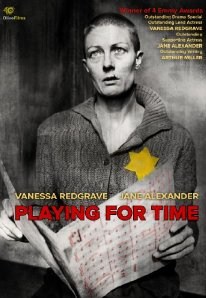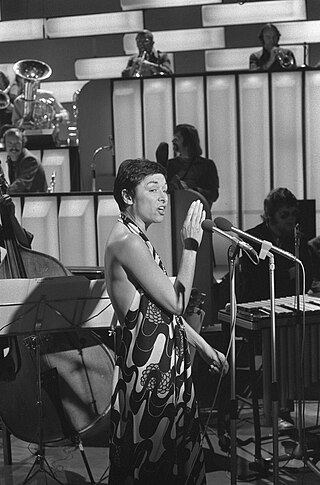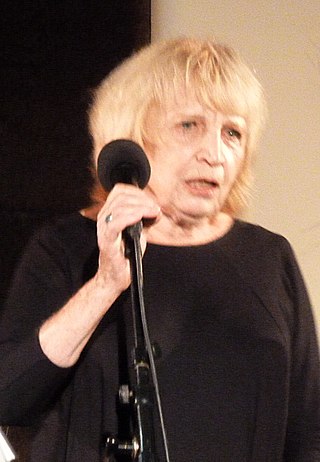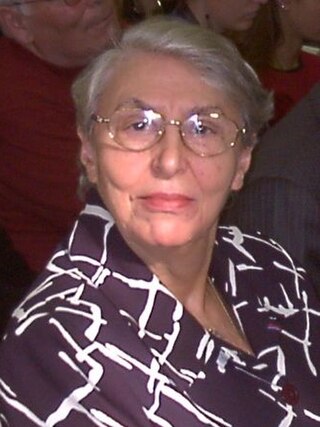
Maria Mandl was an Austrian SS-Helferin and a war criminal known for her role in the Holocaust as a top-ranking official at the Auschwitz-Birkenau extermination camp, where she is believed to have been directly complicit in the deaths of over 500,000 prisoners. She was executed for war crimes.

The Women's Orchestra of Auschwitz was formed by order of the SS in 1943, during the Holocaust, in the Auschwitz II-Birkenau extermination camp in German-occupied Poland. Active for 19 months—from April 1943 until October 1944—the orchestra consisted of mostly young female Jewish and Slavic prisoners, of varying nationalities, who would rehearse for up to ten hours a day to play music regarded as helpful in the daily running of the camp. They also held a concert every Sunday for the SS.

Alma Maria Rosé was an Austrian violinist of Jewish descent. Her uncle was the composer Gustav Mahler. She was deported by the Nazis to the concentration camp at Auschwitz-Birkenau. There, for 10 months, she directed an orchestra of female prisoners who played for their captors to stay alive. As director, Rosé held the status of kapo of the music block.
Fania Fénelon was a French pianist, composer and cabaret singer whose 1976 memoir, Sursis pour l'orchestre, about survival in the Women's Orchestra of Auschwitz during the Holocaust was adapted as the 1980 television film, Playing for Time.

Playing for Time is a 1980 CBS television film, written by Arthur Miller and based on acclaimed musician Fania Fénelon's autobiography The Musicians of Auschwitz. Vanessa Redgrave stars as Fénelon.

Catherine Sauvage was a French singer and actress.

Francesca Solleville is a French singer. She lives in Malakoff (Hauts-de-Seine). She is the granddaughter of the founder of the Italian League for the Rights of Man. She is married to the painter Louis Loyzeau de Grandmaison.
Zofia Czajkowska was a Polish musician chosen to be the first conductor of the Women's Orchestra of Auschwitz.

André Rogerie was a member of the French Resistance in World War II and survivor of seven Nazi concentration camps who testified after the war about what he had seen in the camps.

Marceline Loridan-Ivens was a French writer and film director. Her memoir But You Did Not Come Back details her time in Auschwitz-Birkenau. She was married to Joris Ivens.
Doris Bensimon was an Austrian-born French sociologist and academic whose research focused on the study of contemporary Judaism. She taught at the University of Caen and Institut national des langues et civilisations orientales (INALCO).

Yvette Henriette Lévy is a French educator and survivor of the Holocaust. In July 1944, she was arrested by the Gestapo and was eventually sent to Auschwitz concentration camp. She survived and now educates youths about her experiences. Lévy is a Commander of the National Order of Merit and Officer of the Legion of Honour.
Simon Gutman was a Polish-born French Holocaust survivor.

Annette Wieviorka is a French historian. She is a specialist in the Holocaust and the history of the Jewish people in the 20th century since the 1992 publication of her thesis, Deportation and genocide between memory and forgetting, defended in 1991 at the Paris Nanterre University.
Annette Muller was a French writer and Holocaust survivor. She was an escapee of the Vel' d'Hiv Roundup. Her autobiography, La petite fille du Vel' d'Hiv, published in 1991, gives rare accounts of the roundup and the destiny of her fellow prisoners.

Louise Pioger, also known as Louise Quitrime, was born on June 19, 1848, in Mezières-sous-Ballon, France, and died on December 9, 1920 in Garches. She was a woman laborer in the clothing and textile industry. She made waistcoats and was also an anarchist author and communard active with Women in the Paris Commune. She is known for her nursery rhymes book titled Rondes pour récréations enfantines, which was for a long time wrongly attributed to Louise Michel.
Suzanne Birnbaum, was born in the 5th arrondissement of Paris, and died in Nantes. She was a French Jewish woman, a shopkeeper in Paris and a survivor of deportation to Auschwitz during the Second World War. She is known for having written an autobiographical account of her arrest and deportation from Drancy to Auschwitz.

Ginette Kolinka is a French Holocaust survivor. When her father and brother were taken away to be killed by poison gas, shortly after the train on which they had been transported arrived at Auschwitz, she was selected for factory work and taken to the women's camp. Released in May 1945, she remained silent about her war-time experiences for half a century. Her own explanation for this is that she did not wish to irritate people. Whatever the truth of that, after her husband died, and soon after the dawn of a new century, she became an energetic "ambassador for the memory" of those times, criss-crossing the country to share her holocaust knowledge with school children and students. Thanks to the ensuing media exposure, it is no longer only among children and students that, during the first decades of the twenty-first century, she has heightened awareness of the Shoah and its lessons.

Sonia Mossé was a French artist, Actor, decorator, and draughtswoman who inspired many artists of her time. Close to the surrealist movement, she frequented the Éluard couple, Man Ray and many other prominent artists of that time. Refusing to wear the yellow star, she was probably denounced in 1943 and died murdered in the extermination camp of Sobibór. As an artist, she is known for having made and exhibited a surrealist mannequin for the Exposition Internationale du Surréalisme in 1938.

Andrée Jacob was a member of the French Resistance during the Second World War. Initially working in publishing, she played an active part in the French Resistance during the Second World War. Post war she became a journalist for the newspaper Le Monde, and worked to preserve Parisian cultural heritage. She was the partner of fellow Resistance member Éveline Garnier and the cousin of the artist Max Jacob.



















